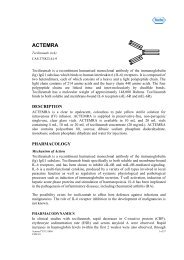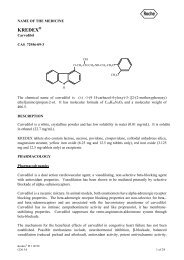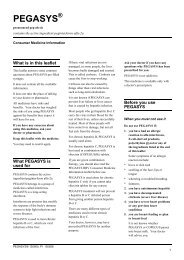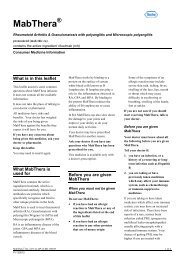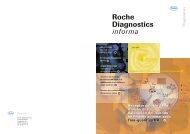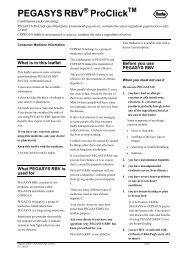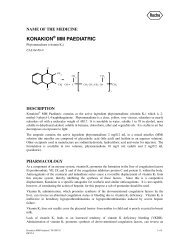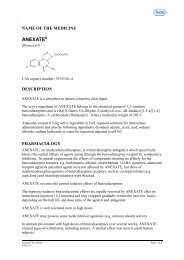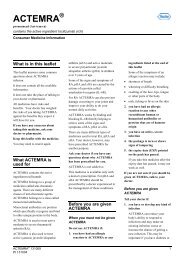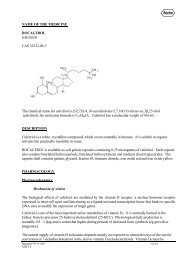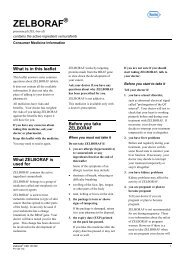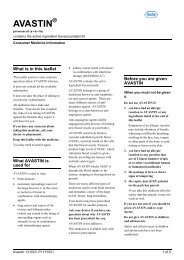Product Information PI - Roche Australia
Product Information PI - Roche Australia
Product Information PI - Roche Australia
Create successful ePaper yourself
Turn your PDF publications into a flip-book with our unique Google optimized e-Paper software.
<strong>Information</strong> derived from pharmacology and pharmacokinetic studies of oseltamivir<br />
phosphate suggest that clinically significant drug interactions are unlikely.<br />
Oseltamivir phosphate is rapidly converted to the active metabolite by esterases, located<br />
predominantly in the liver. Drug interactions involving competition for esterases have not<br />
been extensively reported in the literature. These esterases have been shown not to be<br />
saturable at concentrations of oseltamivir 100 times those which occur during treatment.<br />
Therefore, drug interactions caused by competition for these enzymes are highly unlikely.<br />
In vitro studies demonstrated that neither oseltamivir phosphate nor the active metabolite is a<br />
good substrate for P450 mixed-function oxidases or for glucuronyl transferases. As a result,<br />
drug interactions involving P450 isozymes are unlikely.<br />
Oseltamivir is a weak substrate in vitro for the P-glycoprotein transport system; however, no<br />
adverse event for oseltamivir or the concomitant administrated drug, which could be due to an<br />
interaction at the P-glycoprotein level, has been detected.<br />
Cimetidine has no effect on plasma levels of oseltamivir or its active metabolite.<br />
Clinically important drug interactions involving competition for renal tubular secretion are<br />
unlikely, due to the known safety margin for most of these drugs, the elimination<br />
characteristics of the active metabolite (glomerular filtration and anionic tubular secretion)<br />
and the excretion capacity of these pathways.<br />
No pharmacokinetic interactions between oseltamivir or its major metabolite have been<br />
observed when co-administering oseltamivir with paracetamol, acetyl-salicylic acid (aspirin),<br />
cimetidine, antacids (magnesium and aluminium hydroxides and calcium carbonates),<br />
warfarin, rimantadine or amantadine.<br />
There is no mechanistic basis for an interaction with oral contraceptives.<br />
Drug interaction studies have not been undertaken with oseltamivir and a number of drugs<br />
and drug classes, including erythromycin and macrolide antibiotics, theophylline derivatives<br />
and antihistamines.<br />
Co-administration with amoxicillin does not alter plasma levels of either compound,<br />
indicating that competition for the anionic pathway is weak.<br />
ADVERSE EFFECTS<br />
Experience from Clinical Trials<br />
The overall safety profile of TAMIFLU is based on data from 2647 adults/adolescents and<br />
858 paediatric patients with influenza, and on data from 1945 adult/adolescent and 148<br />
paediatric patients receiving TAMIFLU for the prophylaxis of influenza in clinical trials . In<br />
adult/adolescent treatment studies, the most frequently reported adverse drug reactions<br />
(ADRs) were nausea, vomiting and headache. The majority of these ADRs were reported on a<br />
single occasion, occurred on either the first or second treatment day and resolved<br />
Tamiflu <strong>PI</strong> 6 mg/mL oral suspension and capsules 120119 15 of 28<br />
CDS 10.0



